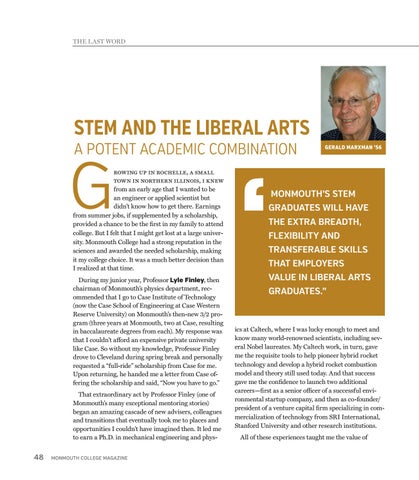THE LAST WORD
STEM AND THE LIBERAL ARTS A POTENT ACADEMIC COMBINATION
G
rowing up in rochelle, a small town in northern illinois, i knew from an early age that I wanted to be an engineer or applied scientist but didn’t know how to get there. Earnings from summer jobs, if supplemented by a scholarship, provided a chance to be the first in my family to attend college. But I felt that I might get lost at a large university. Monmouth College had a strong reputation in the sciences and awarded the needed scholarship, making it my college choice. It was a much better decision than I realized at that time. During my junior year, Professor Lyle Finley, then chairman of Monmouth’s physics department, recommended that I go to Case Institute of Technology (now the Case School of Engineering at Case Western Reserve University) on Monmouth’s then-new 3/2 program (three years at Monmouth, two at Case, resulting in baccalaureate degrees from each). My response was that I couldn’t afford an expensive private university like Case. So without my knowledge, Professor Finley drove to Cleveland during spring break and personally requested a “full-ride” scholarship from Case for me. Upon returning, he handed me a letter from Case offering the scholarship and said, “Now you have to go.” That extraordinary act by Professor Finley (one of Monmouth’s many exceptional mentoring stories) began an amazing cascade of new advisers, colleagues and transitions that eventually took me to places and opportunities I couldn’t have imagined then. It led me to earn a Ph.D. in mechanical engineering and phys-
48
MONMOUTH COLLEGE MAGAZINE
GERALD MARXMAN ’56
MONMOUTH’S STEM GRADUATES WILL HAVE THE EXTRA BREADTH, FLEXIBILITY AND TRANSFERABLE SKILLS THAT EMPLOYERS VALUE IN LIBERAL ARTS GRADUATES.”
ics at Caltech, where I was lucky enough to meet and know many world-renowned scientists, including several Nobel laureates. My Caltech work, in turn, gave me the requisite tools to help pioneer hybrid rocket technology and develop a hybrid rocket combustion model and theory still used today. And that success gave me the confidence to launch two additional careers—first as a senior officer of a successful environmental startup company, and then as co-founder/ president of a venture capital firm specializing in commercialization of technology from SRI International, Stanford University and other research institutions. All of these experiences taught me the value of









